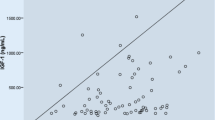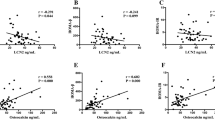Summary
We measured serum concentrations of bone Glaprotein (osteocalcin, BGP) and carboxyterminal propeptide of type I procollagen (PICP) in 14 patients with active acromegaly. Blood was collected at 0800 for measurement of bone Gla-protein (BGP), carboxyterminal propeptide of type I procollagen (PICP), and insulin-like growth factor I (IGF-I); growth hormone (GH) was then determined at 15-minute intervals for 3 hours and the integrated mean was calculated. The same protocol was repeated at regular intervals during treatment with the long-acting somatostatin analog, octreotide, 150–450 μg/day for 6–33 months (median 15). In a case-control analysis, serum BGP concentrations recorded in the acromegalic patients were significantly elevated (14.2±4.2 μg/liter versus 8.0±3.3 μg/liter, P<0.001). Octreotide treatment induced a roughly parallel reduction in serum GH, IGF-I, and BGP. We found a significant positive correlation between BGP levels recorded before and during therapy and the logarithm of corresponding mean GH levels (r=0.67, P<0.001). Also IGF-I concentrations were positively correlated with BGP (r=0.66, P<0.001). On the other hand, PICP levels recorded in the acromegalics did not differ from control subjects (146±46 μg/liter versus 127±44 μg/liter, NS) and no correlation was found between either GH and PICP or IGF-I and PICP. To conclude, the present data are compatible with the view that GH and IGF-I play an important role in the control of BGP but not PICP production. It could be that BGP and PICP are submitted to different hormonal modulation.
Similar content being viewed by others
References
Parfitt AM (1991) Growth hormone and adult bone remodelling. Clin Endocrinol 35:467–470
Azria M (1990) The value of biomarkers in detecting alterations in bone metabolism. Calcif Tissue Int 45:7–11
Duda RJ, O'Brein JF, Katzman JA, Peterson JM, Mann KG, Riggs BL (1988) Concurrent assays of circulating bone glaprotein and bone alkaline phosphatase: effects of sex, age and metabolic bone disease. J Clin Endocrinol Metab 66:951–956
Burgeson RE (1988) New collagens, new concepts. Ann Rev Cell Biol 4:551–577
Prockop DJ, Kivirikko KI, Tuderman L, Guzman NA (1979) The biosynthesis of collagen and its disorders. N Engl L Med 301:13–23, 77–85
Mellko J, Nieml S, Risteli L, Risteli J (1990) Radioimmunoassay of the carboxyterminal propeptide of human type I procollagen. Clin Chem 36/37:1328–1332
Price PA, Parthermore JG, Deftoes LJ (1980) New biochemical marker for bone metabolism. Measurements by radioimmunoassay of bone gla protein in the plasma of normal subjects and patients with bone disease. J Clin Invest 66:878–883
Delmas PD, Malaval L, Arnot PE, Meunier PJ (1988) Serum bone Gla-protein compared to bone histomorphometry in endocrine disease. Bone 6:339–341
Jensen LT, Jorgensen OLJ, Risteli J, Christiansen JS, Lorenzen I (1991) Type I and III procollagen propeptides in growth hormone-deficient patients: effects of increasing doses of GH. Acta Endocrinol 124:278–282
Canalis E, Lian BJ (1988) Effects of bone-associated growth factors on DNA, collagen and osteocalcin synthesis in cultured fetal rat calvariae. Bone 9:243–246
Johansen JS, Giwercman DH, Hartwell D, Nielsen TG,Price PA, Christiansen C, Skakkebaek NE (1988) Serum bone Glaprotein as a marker of bone growth in children and adolescents: correlations with age, height, serum insulin-like growth factor I, and serum testosterone. J Clin Endocrinol Metab 67:273–278
Daughday WH, Rotwein P (1989) Insulin-like growth factor I and II. Peptide, messenger ribonucleic acid and gene structures, serum, and tissue concentration. Endocrine Rev 10:68–91
Delmas PD, Chatelain P, Malaval L, Bonne G (1986) Serum bone Gla-protein in growth hormone-deficient children. J Bone Miner Res 1:333–338
Johansen JS, Jensen SB, Riis J, Rasmussen L, Zachmann M, Christiansen C (1990) Serum bone Gla-protein: a potential marker of growth hormone (GH) deficiency and the response to GH therapy. J Clin Endocrinol Metab 71:122–126
Sartorio A, Conti A, Guzzaloni G, Faglia G (1990) Serum osteocalcin levels in patients with GH deficiency before and during GH treatment. Acta paediatr Scand 80:100–102
De la Piedra C, Larranaga ECJ, Castro N, Horcajada C, Rapado A, Herrera Pombo JL (1988) Correlation among plasma osteocalcin, growth hormone, and somatomedin C in acromegaly. Calcif Tissue Int 43:44–45
Halse J, Melsen F, Moseskilde L (1981) Iliac crest bone mass and remodelling in acromegaly. Acta Endocrinol 97:18–22
Barkan AL, Beitinis IZ, Kelch RP (1988) Plasma insulin-like growth factor in acromegaly: correlation with the degree of growth hormone hypersecretion. J Clin Endocrinol Metab 67: 69–73
Ho KY, Weissberger AJ, Marbach PM, Lazarus L (1990) Therapeutic efficacy of the somatostatin analog SMS 201-995 (octreotide) in acromegaly. Ann Intern Med 112:173–181
Johansen JS, Pedersen SA, Jorgensen JOL, Riis BJ, Christiansen C, Christiansen JS, Skakkebaek NE (1990) Effects of growth hormone (GH) on plasma bone-Gla protein in GH-deficient adults. J Clin Endocrinol Metab 70:916–919
Carey D, Goldberg B, Ratzan SK, Rubin KR, Roewe DW (1985) Radioimmunoassay for type I procollagen in growth hormone-deficient children before and during treatment with growth hormone. Pediatr Res 23:167–171
Smedsrod B, Melkko J, Risteli L, Risteli J (1990) Circulating carboxyterminal propeptide of type one procollagen is cleared mainly via the mannose receptor in liver endothelial cells. Biochem J 271:345–350
Farrugia W, Melick RA (1986) Metabolism of osteocalcin. Calcif Tissue Int 39:234–238
Author information
Authors and Affiliations
Rights and permissions
About this article
Cite this article
Terzolo, M., Piovesan, A., Osella, G. et al. Serum levels of bone GLA protein (osteocalcin, BGP) and carboxyterminal propeptide of type I procollagen (PICP) in acromegly: Effects of long-term octreotide treatment. Calcif Tissue Int 52, 188–191 (1993). https://doi.org/10.1007/BF00298716
Received:
Revised:
Issue Date:
DOI: https://doi.org/10.1007/BF00298716




